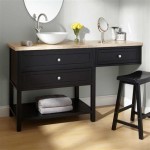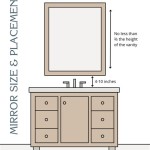Round Or Rectangle Undermount Bathroom Sink: A Comparative Analysis
Selecting the appropriate bathroom sink is a crucial decision impacting both the functionality and aesthetic appeal of the space. Undermount sinks, installed beneath the countertop, offer a seamless and clean look, facilitating easy cleaning and maximizing counter space. Within the undermount category, two primary shapes dominate the market: round and rectangle. Each shape offers distinct advantages and disadvantages regarding design compatibility, space utilization, and overall practicality. This article will provide a detailed comparison of round and rectangle undermount bathroom sinks to assist in making an informed decision based on individual preferences and bathroom requirements.
Aesthetic Considerations: Shaping the Bathroom Ambiance
The shape of a bathroom sink significantly contributes to the overall ambiance of the bathroom. Round undermount sinks tend to project a softer, more organic feel. Their curved lines create a sense of fluidity and can complement bathrooms designed with a traditional, transitional, or even minimalist aesthetic. The absence of sharp angles softens the visual impact of the basin, making it suitable for creating a relaxing and comfortable atmosphere. Conversely, rectangle undermount sinks offer a more modern and geometric appeal. Their clean, straight lines lend themselves well to contemporary and industrial-style bathrooms. The sharp angles and defined edges project a sense of order and sophistication, contributing to a sleek and upscale design scheme.
Furthermore, the choice between round and rectangle sinks can influence the perceived size and depth of the bathroom. Round sinks, due to their curved nature, might appear smaller than rectangle sinks of similar dimensions. Rectangle sinks, with their defined edges, tend to occupy more visual space, potentially making a smaller bathroom feel slightly more confined. The color and material of the sink also play a crucial role in its visual impact. A dark-colored rectangle sink will appear more prominent than a light-colored round sink of the same material.
Ultimately, the aesthetic choice between round and rectangle undermount sinks depends heavily on the desired overall bathroom design. If the goal is to create a soft, inviting, and potentially more traditionally styled space, a round sink may be preferable. If a modern, minimalist, or industrial look is desired, a rectangle sink might be the better option.
Practicality and Functionality: Evaluating Daily Use
Beyond aesthetics, the practicality and functionality of a bathroom sink significantly impact daily use. Round and rectangle sinks differ in their capacity, water containment, and ease of cleaning. While the differences might seem subtle, they can influence the overall user experience.
Rectangle sinks, especially those with generous dimensions, generally offer a larger basin area, providing more space for washing hands, face, or other items. The straight sides of a rectangle sink allow for more efficient use of the available space within the basin. This can be particularly advantageous in bathrooms where multiple users frequently share the sink. Round sinks, although visually appealing, might have a slightly reduced usable basin area due to their curved shape. Water splashing can also be a factor, as the curved sides of a round sink might allow for more splashing compared to the straight sides of a rectangle sink, particularly when the water stream is strong.
Cleaning is another critical aspect to consider. Rectangle sinks, with their sharp corners, can sometimes pose a challenge in terms of cleaning. Dirt and grime can accumulate in the corners, requiring more attention and effort to maintain cleanliness. Round sinks, with their smooth curves, are generally easier to clean, as there are no sharp corners for dirt to accumulate. However, the choice of material significantly impacts the ease of cleaning regardless of shape. For instance, a ceramic sink, whether round or rectangle, is generally easier to clean than a sink made from a more porous material like stone.
In terms of installation, both round and rectangle undermount sinks require professional installation to ensure a seamless and watertight seal with the countertop. The complexity of the installation process is generally similar for both shapes, although specific countertop materials might present unique challenges. For example, installing an undermount sink in a granite countertop requires specialized tools and techniques to prevent chipping or cracking.
Space Optimization and Layout Considerations
The space available in the bathroom and the overall layout significantly influence the suitability of a round or rectangle undermount sink. In smaller bathrooms, optimizing space is crucial, and the choice of sink shape can play a significant role in maximizing the usable area. Round sinks, due to their compact footprint, are often a good choice for smaller bathrooms or powder rooms. Their curved shape can create the illusion of more space, making the bathroom feel less cramped. They also tend to pair well with smaller vanities.
However, in larger bathrooms, rectangle sinks can be accommodated without compromising space. A larger rectangle sink can even serve as a focal point in a spacious bathroom, adding a touch of elegance and sophistication. Double vanity setups, which are common in master bathrooms, often utilize rectangle sinks to provide ample space for two users. The straight lines of rectangle sinks also complement the rectangular shape of most bathroom countertops and vanities, creating a cohesive and balanced look.
The positioning of the sink in relation to other bathroom fixtures, such as the toilet and shower, should also be considered. In tight spaces, ensuring adequate clearance around the sink is essential for comfortable movement and accessibility. A round sink might be preferable in situations where space is limited and maneuvering around the sink is necessary. However, if the bathroom layout allows for ample space, the choice between round and rectangle sinks becomes more a matter of personal preference and aesthetic considerations.
The size and depth of the sink also impact its usability. A shallow sink, regardless of shape, might be prone to splashing, while a very deep sink might be uncomfortable for some users, particularly children. The ideal sink depth should be chosen based on the height of the users and their individual preferences. Additionally, the height of the vanity and countertop should be considered to ensure that the sink is at a comfortable working height.
Ultimately, the optimal choice between a round and rectangle undermount sink depends on a careful assessment of the available space, the overall bathroom layout, the desired aesthetic, and the practical needs of the users. By considering these factors, it is possible to select a sink that not only complements the bathroom design but also enhances its functionality and usability.

Undermount Bathroom Sink Buyer S Guide The Family Handyman

Bathroom Dilemma Rectangular Or Oval Sink Yay Nay

Deervalley Ursa 18 11 In Undermount Rectangular Bathroom Sink With Overflow Drain White Vitreous China Dv 1u306 The Home Depot

Undermount Rectangle Bathroom Sink With Center Drain Overflow

Swiss Madison Plaisir 21 In Rectangular Undermount Bathroom Sink Glossy White Sm Um623 The Home Depot

Kingston Brass Courtyard Lb18127 Ceramic Rectangular Undermount Bathroom Sink White

Lordear 28in Undermount Bathroom Sink Rectangular Pure White Vitreous Ceramic Lavatory Vanity Vessel Sinks

Allen Roth White Undermount Rectangular Traditional Bathroom Sink 19 69 In X 15 75 The Sinks Department At Com

Rectangular Undermount Ceramic Bathroom Sink White Kraus Usa

Stylish Porcelain Sinks White Undermount Rectangular Modern Bathroom Sink 14 5 In X 21 25 The Department At Com
Related Posts







